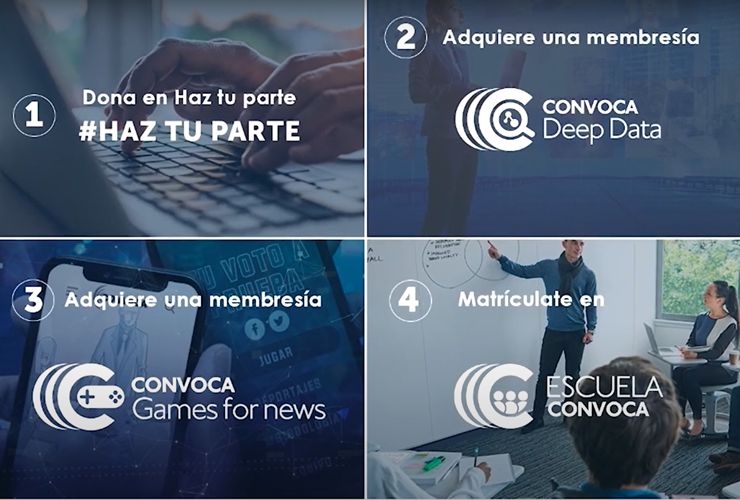Local Journalism Project Case Study: Convoca (Peru)
The backstory:
Convoca was born as an investigative journalism association in 2014, founded by a team of journalists, developers, and data analysts. They started as a partnership to conduct investigations, and their first publication was their contribution to the Swiss Leaks investigation. The team had their main jobs and worked on Convoca on the side until they won a grant for a second big investigative project.
Convoca operates in a challenging media environment. The main threat to media freedom in Peru comes from defamation laws, which often lead to journalists being threatened, intimidated, or prosecuted. Media income and ownership are very concentrated in Peru, especially in the print and online media. In recent years, reporting has been complicated by a lack of transparency and difficulties in access to official information.
Audience:
Convoca readers are typically between the ages of 18 and 45, professionals with a critical view of reality and who are looking for different content. Thanks to their programme “Convoca Servicios”, Convoca grew from 80,000 users to three million users during the pandemic.
Value proposition:
The main goal of Convoca is to produce high-quality investigative reporting, but they also aim to teach and promote the practice of high-quality journalism. “We want to have an impact on the authorities. From the very beginning, Convoca has aimed to generate changes in public policy”, founder Milagros Salazar says.
The team:
The Convoca team is made up of around ten people, including system engineers, computer technicians, and journalists.
Product and distribution:
Convoca focuses mainly on investigative series, rather than snapshots of current affairs. They also have a service section with “news you can use”, called “Convoca Servicios”, which has been crucial to their growth. They distribute their podcast through alliances with more than 40 local radio stations in Peru, Mexico, and Bolivia.
Business model:
In the search for long-term sustainability Convoca has tried several strategies to diversify its income. In 2016 they conducted a crowdfunding campaign and in 2018 they launched a school for data journalism training.
The operation is nowadays based on four pillars. The first is the media outlet itself, Convoca.pe, which operates on a mixed revenue model, consisting of grants, scholarships, and alliances with different organizations.
The second one is ConvocaEscuela, which in addition to courses and workshops, also publishes digital books and organizes events such as investigative and data journalism congresses. The third pillar is Convoca Deep Data, a platform for data analysis on extractive industries in Peru. Convoca Deep Data is based on a freemium membership model that allows free access to basic data but charges for more advanced features. The fourth is Games for News, an offshoot of Convoca Lab, which is their experimentation space to find new revenue streams.
The future:
ConvocaLab is the outlet’s innovation laboratory. It has generated new storytelling formats, including interactive comics, interactive games, 360° videos, and podcasts.
Ask them about:
How they built and manage Convoca Deep Data, a data analysis platform on extractive industries in Peru. They processed 2.4 million pieces of data, and analyzed information that dated back 100 years, assessing indicators that measure, for instance, the level of non-compliance with environmental and labor regulations in the last 15 years. Additionally, they processed a 16-year period of information that contains over 200 open files on environmental matters and a registry of penalties and sanctions imposed between 2014 and 2019.
In their words:
“Convoca emerged as a group of people who wanted to do journalism that would contribute to generating changes in public policy.”
“Journalists can learn that data can not only be used as a source for immediate publications, but also that it can be integrated with other databases to generate open data platforms such as Convoca Deep Data.”
“We had experience in working with databases and were very curious as to how to use technology to serve journalism. We thought that there wasn’t a single newsroom with these characteristics in Peru, and we wanted to create a project to pioneer this.”
“Our methodology for collaboration is that we are the ones who will build or organize all the information and then we distribute it to partners and accompany that process.”
“We launched a data analysis platform so that media, civil society, and universities could analyze and cross-reference their own databases from a platform we call Deep Data. And that has a business model, of course, which is subscription and memberships in a freemium model.”
Source for information and views in this case study: Interview with Milagros Salazar, founder and editor-in-chief, Convoca Perú.
This story is part of IPI’s Local Journalism Project. The publication of these case studies – part of IPI’s wider work mapping, networking and supporting quality innovative media serving local communities – is supported by the Friedrich Naumann Foundation.



